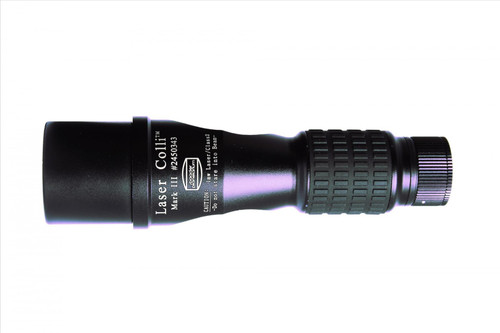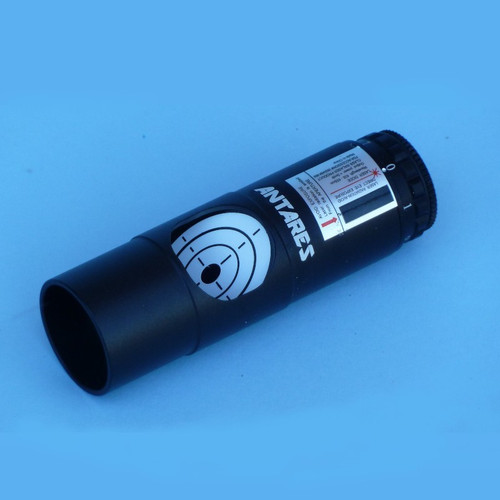Product Overview
USED equipment - Tested
HoTech 2" SCA Crosshair Laser Collimator
The HoTech 2" SCA Crosshair Laser Collimator separates itself from all other laser collimators with its innovative self-centering adapter technology (SCA). This mechanism allows precise and REPEATABLE installation in all brands of 1.25" and 2" telescope focusers thus provides accurate collimation. All laser collimators in the current market have one fundamental problem, slop in the adapting mechanism between the laser collimator and the telescope focuser.This problem is clearly recognized and often discussed among astronomers but so far there has been no definite solution in the market. No matter how tightly the tolerances machined on the laser collimator or the focuser, a small gap is required to allow installation of the laser collimator. Once the laser collimator is inserted, the required gap becomes a problem. A laser collimator is secured with one or more thumbscrews or unified compression ring. Both methods introduce very critical issues, namely inconsistant adaption from off-axis (axial) and none parallel-axis installment that instantly destroys the precision of your collimation instrument along the entire optical axis. Our Self-Centering Adapter cleverly eliminates the focuser slop by linearly compressing the built-in rubber rings. By doing this, the diameter of the rings expands to compensate the gap.Because all rings evenly expand radially in diameter from the compression, this automatically centers the laser collimator in the focuser draw tube. And most importantly, our SCA laser collimator can be tightly installed in the focuser for a repeatable installation to provide an accurate collimation. In summary, our SCA adapter serves three critical functions. First, its expansion rings accommodate almost all focuser's manufacturing tolerances. Second, it automatically centers the adapting laser in the focuser. Third, it provides at least two evenly distributed circular contacts on the focuser's inner tube surface preventing the adapting laser from pivoting and parallel to the focuser.Once the slop factor is taken away, you can quickly collimate your telescope in confidence to achieve perfect collimation every time.
SCA Eliminates Drawtube Slop
All drawtube have manufacturing tolerances. And it requires larger diameter to accept various eyepieces and adapters. When a standard collimator is inserted, the gap between the drawtube and the inserting device became a slop problem. The rubber rings in the SCA expand radially according to users own adjustment to fill the gaps. This makes your collimator seats firmly in your drawtube becoming part of your telescope for a secure and repeatable installation.
SCA Keeps Laser Perfectly Parallel to the Focuser
The patented multiple expanding o-rings design provides solid 360 degress even grip to the inner focuser surface keeping the adapting laser perfectly parallel to the focuser tube eliminating any possible tip or tilt error from the conventional thumbscrew locking mechanism.
SCA Eliminates unstable locking from thumbscrew or unified compression ring
The optical axis is shifted when the inserting device is locked in by thumbscrew.In some cases, some poorly made unified compression ring can cause unstable tilt when locking in the drawtube due to loose tolerances between the compression ring, inner groove, and the uneven tip of the locking thumbscrew in a drawtube.The SCA adapts the collimator itself without using the thumbscrew or the unified compression ring.
SCA Accepts the Imperfection of a Drawtube
Small imperfection inside the drawtube like dents, scratches, and uneven burrs, the rubber rings compensates the errors and faithfully centers the collimator in the tube.In addition, even if the drawtube is slightly deformed in diameter, egg-shaped, the rubber rings in the SCA will compensate the differences and faithfully centers the collimator. A metal collet design will not be able to transform itself to the deformed shape to compensate the imperfection of a drawtube for a sturdy adaption.
More SCA Laser Collimator Features:
Laser Engraved 45º Targeting Faceplate
The targeting faceplate displays the returning laser spot with a clear visual reference during adjustment. That allows you to align your primary mirror from the rear of the telescope and eliminates traveling to the front of your scope repeatedly during collimation. Collimating without the targeting faceplate, you will not be able to adjust the primary mirror in real time referencing the laser dot. In other words, you often get lost on which adjustment screws you used due to traveling back and forth for referencing the direction you have adjusted. This results in considerable time to complete the collimation and defeats the purpose of quick and easy laser collimation. HoTech understands the importance of this, so the faceplate is a standard feature in our laser collimator. All astronomers deserve to have it without paying any extra! HoTech understands the importance of this, so the faceplate is a standard feature in our laser collimator. All astronomers deserve to have it without paying any extra! In addition, our faceplate viewer’s pattern is laser engraved to ensure a long lasting sharp targeting grid for best visual effects. Unlike other collimators, the target is not a sticker that will peel, or paint that can rub or chip off. We understand that you are paying for a precision instrument that is supposed to be well made.
Finest Projecting Laser Dot
Keeping the laser dot to the finest point is the key to precision collimation. But when you look closely at the laser dot from brand to brand, most laser dots appear large, not really a fine point as you imagined. This means there is guess work involved when you try to center the dot; not just centering the laser dot to the center of the faceplate, but also centering the center of the dot itself. This does not make any sense when you are trying to take the advantage of the collimated laser beam's characteristic "which has a low beam divergence, so that the beam radius does not undergo significant changes within moderate propagation distances." In other words, the laser beam size within the collimation distance (laser collimator to the primary mirror and back to the faceplate) should remain a constant fine point. As you know, most laser collimator brands are not really laser manufacturers. They install an off-the-shelf laser module or pointer and align the laser in a tube without REALLY considering the user’s application, namely the operating distance for a laser beam size. HoTech has been designing and building laser modules and systems for over 10 years for various professional industries. We know exactly how a laser should work. We limit our laser beam to the finest size in the correct operating distance for optimal effect. Our understanding and experiences with the laser design permit you to have an effective and precision collimation.









